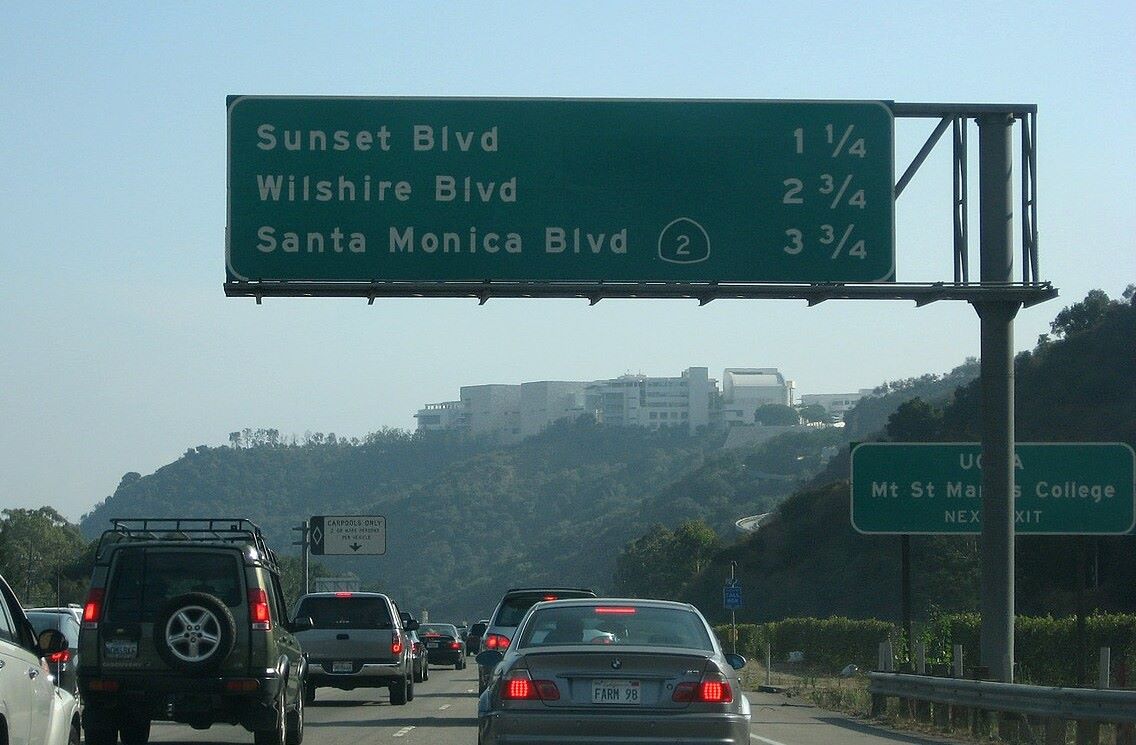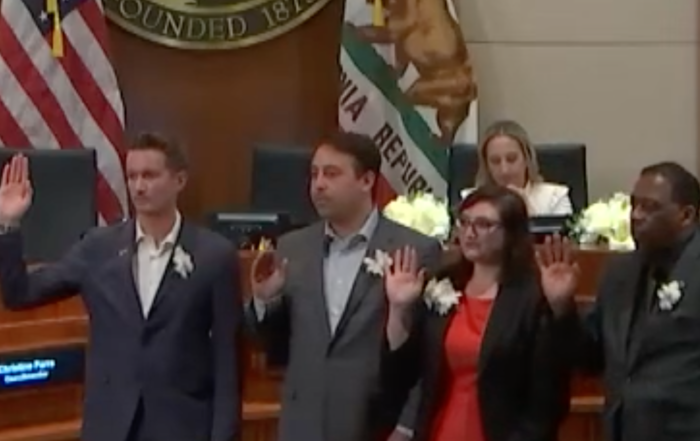The Sepulveda Transit Corridor (STC) is a Los Angeles Metro project that would link the San Fernando Valley to the Westside. It is still in its environmental study phase with draft Environmental Impact Reports to be released in early 2025. Metro entered into a Private-Public Partnership with two companies, L.A. SkyRail Express (LASRE) and the Sepulveda Transit Corridor Partners (STCP) to develop alternatives that aim to transform the notorious traffic bottleneck in the Sepulveda Pass.
Two modes of transportation – an above-ground monorail that follows the 405 from SkyRail and a heavy rail that operates underground from STCP – are currently preparing draft Environmental Impact Reports (DEIR) to be released early next year. After a period for public review and comment, Metro will select an alternative and estimate that the STC will open in 2033-2035.
Alternatives 1-3 are monorail proposals that would follow the 405 up and over the Santa Monica mountains. Alternatives 4-6 are heavy rail proposals that would bore through the Santa Monica Mountains. Alternative 6 was proposed by Metro and is the only route that would employ conductors – the other five would be automated.
Dreams of a Metro rail line through the Sepulveda Pass date back to the 1970s. In 2008, Measure R provided the first seed money for what would become the ambitious STC project. The passage of Measure M in 2016 afforded more funding for travel improvements between the Westside and San Fernando Valley.
The Sepulveda Pass sees around 400,000 trips per day. Less than two percent of these trips are made by public transit. The STC project has been described as “One of the largest and most significant public works projects in the history of Los Angeles – and the nation” by the University of California, Los Angeles (UCLA).
Starting in 2021, Metro began soliciting public comment about the project. In the agency’s cumulative findings over the last four years, respondents favored the heavy rail option by a large majority – as much as 93 percent in one report. Central to many community concerns was the inclusion of a direct stop at the UCLA campus and a direct connection to the soon-to-be-completed Purple/D Metro line.
In 2022, UCLA submitted a formal comment to Metro, saying they were strongly opposed to two of the monorail alternatives and would oppose the third monorail alternative without serious amendments to the proposal. The school endorsed all of the heavy rail options.
Sepulveda Transit Corridor 4 All (STC4All), a coalition dedicated to transit equity, sees the project as an opportunity to radically improve Westside mobility. STC4All is “Agnostic” on the heavy rail or monorail question, but they want a direct stop at UCLA and an easy transfer to the Purple/D Line. The coalition advocates for Alternatives 3 through 6 because they rise to their goals of a sustainable and equitable corridor.
Rohan Abraham, a recent UCLA graduate and STC4All ambassador, said the cost of living at UCLA and the lack of efficient transit options create a miserable situation for commuters. “Getting anywhere seems to take twice as long by public transport than it does by car,” he said. The frustration with commuting to campus has led to overwhelming support for the STC project at UCLA.
“There’s so much room for improvement with this transit project that it’s impossible to deny its importance,” Abraham said.
STC4All has been actively organizing and keeping the community up-to-date on the project. On July 3, Metro eliminated Alternative 2 – a monorail that would use an automated people mover to get from the monorail line to UCLA’s campus. The SkyRail company requested the option be removed and Metro agreed after a period of public comment.
The dearth of affordable housing in UCLA’s neighborhood means that many of the students and employees of the fourth-largest employer in L.A. County commute to campus. Twenty-six percent of those commuters live north of the school. More than 9,000 students and employees live in the San Fernando Valley. Currently, the travel time from the San Fernando Metrolink station to UCLA is 90 minutes at peak traffic. With a direct stop on a heavy rail line, riders could make the same trip in 16 minutes or less.
Monorails are slower than heavy rails in general, but the planning of the alternatives also appeals to homeowners in wealthy neighborhoods on the Westside because the routes largely avoid them. The monorail options require transfers or detours around protected historical sites, which slows down the transit time and makes the transit route much less appealing to many of the riders who would use it in the future. The travel times to UCLA are estimated at 24 to 39 minutes on a monorail route.
Assemblymember Laura Friedman and Westside U.S. Representative Ted Lieu both endorsed the project. Though they didn’t specify which alternative they favored, they both said that a direct stop at UCLA was a high priority and endorsed STC4All. Only one of the active monorail alternatives includes a direct stop at UCLA. Recently, Assemblymember Friedman said she wanted an alternative that was “Rider-centric” and efficient, one that “Doesn’t force people to stand in the middle of the highway.” Among other concerns about the monorail options, some have worried that the noise, car emissions, and precarious travel routes to the station will leave riders with an option that favors cars at the expense of transit riders’ health and comfort.
In 2022, City Councilmember Nithya Raman who represents parts of Sherman Oaks and Bel Air, joined other councilmembers in a letter supporting the project and stating their preference for the Metro to prioritize the best option over the cheapest one.
The heavy rail alternatives would theoretically cost more and take more time to build than the monorail options, but supporters say it’s well worth the upfront investment. The heavy rail options would result in lower travel times and higher ridership. On average, heavy rail options would provide 107,000 to 121,000 trips per weekday. The monorail options would net significantly less – from 64,000 to 86,000.
“I think the ridership and travel times speak for themselves,” Rohan Abraham said. He personally prefers the heavy rail options
Another obstacle with a monorail alternative that rides in the middle of the 405 is CalTrans, who noted to Metro that the monorail plans in particular would require “Extensive dialogue, agreements, easements, and permits” with the department. CalTrans warned that each of the alternatives would encroach on CalTrans’s “Right-of-way.” In 2019, Metro claimed that a light rail on the 405 was essentially impossible because CalTrans would never agree to it.
There is yet another potentially costly hurdle to the heavy rail alternatives: homeowners in Bel Air and Sherman Oaks have emerged as the primary challengers to the rail line. Most of the neighborhood councils in the proposed area of the heavy rail have been supportive of the option. But Bel Air has been a vocal and litigious outlier, threatening to pursue legal action against the Metro for their heavy rail proposals.
Homeowners have expressed fears about eminent domain and damage to their houses should a heavy rail be constructed underneath their feet. They’ve enjoyed a lot of press already. Bel Air resident and ex-CEO of Ticketmaster Fredric Rosen has been the public face of the anti-heavy rail options. In emails to Metro executives, he’s said the transit agency should fund the repaving of all roads in Los Angeles instead of transit projects. “This is a car culture,” he said. Personal feelings towards Metro leadership – he said they would have been tarred and feathered in “The old days” bleed into an overall distaste for the Metro who he called “Braindead, hopeless, and incompetent.”
Opponents of the heavy rail claim Metro hasn’t been forthright about the cost and potential impact of the proposals. Metro responded to 20 questions from the Sherman Oaks Homeowners Association, pointing to publicly available reports and communiques from the agency.
Rosen said Bel Air residents are prepared to duke it out with the agency in court. “We are not going away,” he said.
The wealthiest on the Westside often oppose mass transit projects. The Expo/E line from Downtown L.A. to Santa Monica was fought for years by homeowners in Cheviot Hills.
The Beverly Hills Unified School District spent more than $20 Million on legal fees in a protracted battle against the Metro’s Purple Line extension. The district ultimately failed to stop Metro from tunneling in their proximity. Anxieties around the boring required to construct the heavy rail tunnels aren’t baseless – the construction of the Red/B Line caused a gas explosion and some sections of Hollywood Boulevard to sink by nine inches.
But boring technology has improved in the 30 years since the Red/B Line’s construction. Metro said their modern boring machines produce “No noticeable noise, vibration, or settlement at the ground surface.” Sepulveda Transit Corridor Partners, the company responsible for two of the heavy rail alternatives, also said it was “Committed to NO destruction of housing units in the building of this project.”
The Sepulveda Transit Corridor is a project decades in the making with about a decade to go. In the last 30 years, Metro built a mass transit system and is continuing to expand.
Today, L.A. Metro is nearing one million weekday rides.
The timeline and cost estimates of the project alternatives are unconfirmed. Metro said those details will emerge as they get deeper into the planning process. Hearing skepticism about the timing and effectiveness of the project doesn’t discourage Abraham. He encouraged community members to get involved by attending public meetings and staying in the loop on the project. “The pace is picking up. It’s going to be getting off the paper.”
Photo by Downtowngal, CC BY-SA 3.0, via Wikimedia Commons.
Stay informed. Sign up for The Westside Voice Newsletter
By clicking submit, you agree to share your email address with Westside Voice. We do not sell or share your information with anyone.








